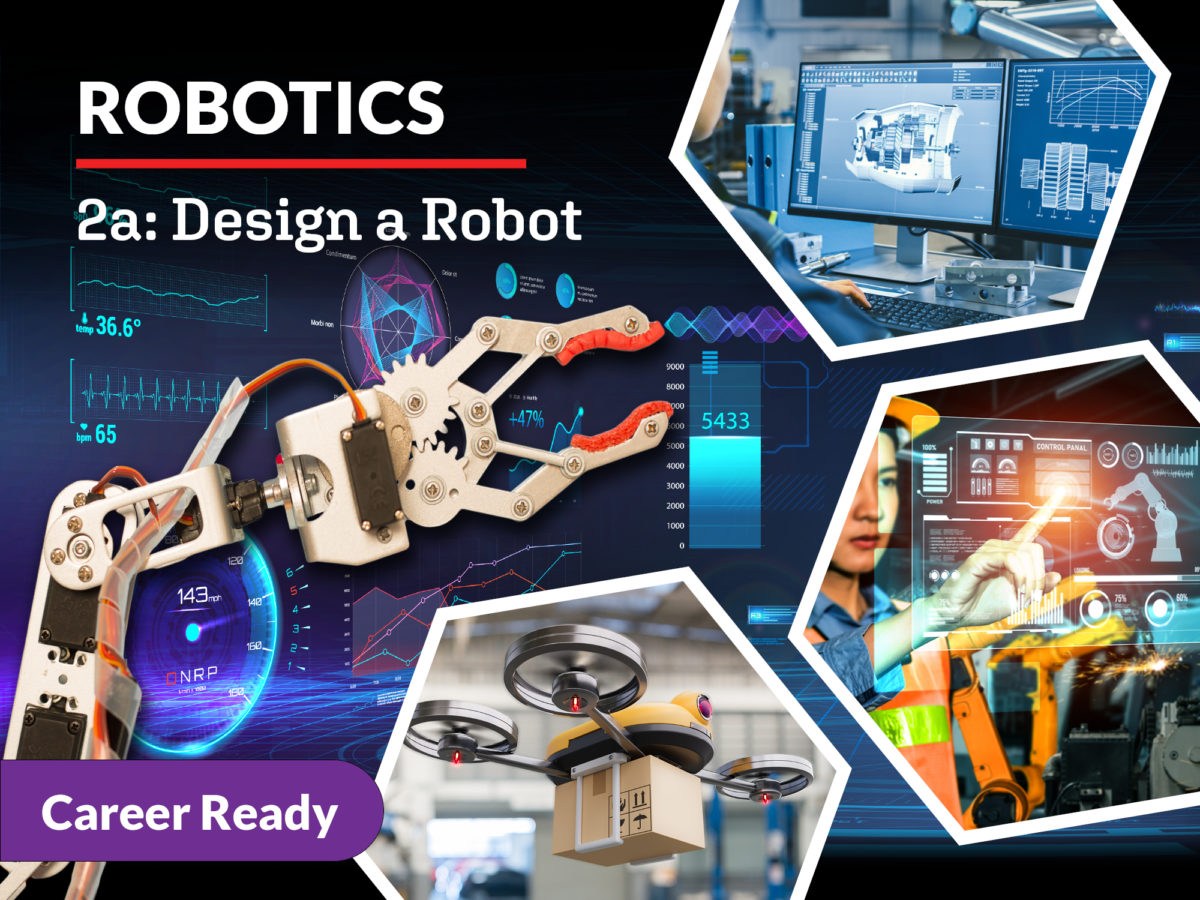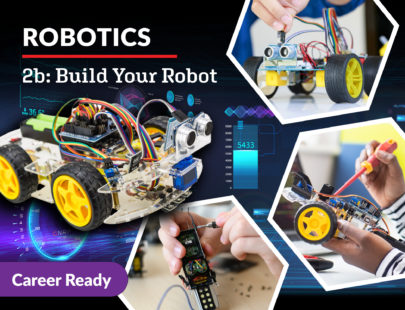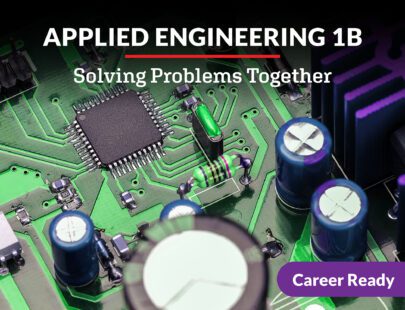
Robotics 2a: Design a Robot
From outer space to the oceans and everywhere in between, robots are doing everything from solving complex problems to simply making daily life easier. But, there has to be a beautiful mind behind the machine, and this is where you come in! In this course, you will identify a problem and using the skills you’ve learned, you will apply the principles of engineering and robotics to design an innovative robot to solve the problem. Robotics engineers are problem solvers ̶ are you ready to step up?
Units at a Glance
Unit 1: Objects in Space
In 2021, the spacecraft carrying the Mars Perseverance rover jettisoned its heat shield before entering the blazing-hot atmosphere of Mars. An enormous parachute opened and carried the robot to the planet’s surface. Perseverance kicked up dirt and rocks billions of years old as it landed. The six-wheeled robot’s purpose is to collect rocks and data, including signs of ancient life. Space has long captured our imagination, and we’ve come a long way. In this age of automation and technology, robotics plays a key role in space exploration and research missions. After we examine the historical roots of flight and space travel, we’ll dive into the role of robotics and automation in troubleshooting space. What does space travel hold over the next 10, 20, or 30 years? What problems might current and future engineers face? How can robotics play a role in solving those problems? What problems can you solve using the principles of flight?
What will you learn in this unit?
- Explain how airplanes are designed to give humans the ability to fly
- Identify the basic components of a rocket and the stages of a rocket’s flight
- Compare and contrast the different types of fuels used by rockets
- Describe the use of robots in modern space exploration
Unit 2: Robotics on Earth
Humans gather a variety of resources from the natural world that we need for survival: food, clothing, and shelter. Beyond that, advanced civilizations have also learned how to navigate, circumvent, and control the elements to build better cities and livelihoods. As civilizations grew, the structures they built became bigger, longer, and more advanced. In the modern world, we are doing something similar by using robotics to help us further harness all that nature has to offer.
What will you learn in this unit?
- Identify types of transportation and their potential future applications
- Distinguish between different types of dams, the materials used to build them, and robotic applications
- Describe how humans redirect and control water using dams and canals, and the role of robotics in these processes
- Explain the steps taken by engineers and the robotic technology they use to ensure that their structures are precise, efficient, and stable
Unit 3: On the Assembly Line
Robots are taking our jobs! You may have heard this statement before, but how accurate is it? Robots and robotic components have been in the workforce for decades now, but rather than making us obsolete, robots are possibly just making our work easier by doing the necessary but tedious or dangerous tasks for us. How are robots accomplishing this? In the process of adding these devices to the workforce, what new jobs and opportunities have been created?
What will you learn in this unit?
- Summarize how computer-integrated manufacturing (CIM) is used to improve manufacturing by integrating robotics into industrial processes
- Identify the different components of a manufacturing robot, including its functions and limitations
- Analyze how robots are being used in health care along with current breakthroughs and other areas of growth
- Compare manual and automatic farming practices, noting the benefits of using robots in agriculture
Unit 4: Really Smart Robots
Robots are taking our jobs! You may have heard this statement before, but how accurate is it? Robots and robotic components have been in the workforce for decades now, but rather than making us obsolete, robots are possibly just making our work easier by doing the necessary but tedious or dangerous tasks for us. How are robots accomplishing this? In the process of adding these devices to the workforce, what new jobs and opportunities have been created?
What will you learn in this unit?
- Summarize how computer-integrated manufacturing (CIM) is used to improve manufacturing by integrating robotics into industrial processes
- Identify the different components of a manufacturing robot, including its functions and limitations
- Analyze how robots are being used in health care along with current breakthroughs and other areas of growth
- Compare manual and automatic farming practices, noting the benefits of using robots in agriculture
Unit 5: The Design Process
Building a robot is not quite like making Grandma’s famous cookies. Although they are delicious, you can’t follow the path someone else has taken and expect to get something new and exciting. Robotics is innovative, and the boundaries are constantly moving. This means that building a robot requires you to be in charge. When making cookies, you need to have the exact ingredients, temperature, and baking time. With robotics, you need to identify a problem, do research, and plan before you are finally ready to begin the building process. Let’s explore what it takes to be ready for construction when designing a robot.
What will you learn in this unit?
- Using the design process model, identify a problem and solution that incorporates robotics
- Summarize some of the basic tools and power sources used in robotics
- Apply mathematical concepts to a robotics problem in order to present designs and models
- Write a proposal for a robotics project that solves a problem
Unit 6: Presenting Your Solution
How you would build a robot in your bedroom is very different from how an engineer at their workplace would build a robot. You might tinker, play around, and find some instructions online. An engineer would think, research, plan, document, prototype, and propose before even starting to think about building. Here, we will continue to explore the topic of moving from robot hobbyist to robot professional as we dive a little deeper into the process of building a robot professionally from start to finish. We will also go over the process of presenting your robot solution—both on paper and through a presentation—and the necessary documentation that goes with it.
What will you learn in this unit?
- Summarize how your robotics idea can be presented to an audience at various levels
- Write a methodology for solving a problem you have identified using robotics
- Describe orally and in writing your robot and the problem or problems it will solve
- Create and interpret engineering drawings and electrical schematics for a robot
Unit 7: Working Together
You have probably been on some great and productive teams over the years and some…not-so-productive teams. By and large, robotics engineering is a team effort; it requires participants to work with others to reach an established goal. What qualities make a team productive and efficient? What can a team do to reach its goals? Let’s take a look at some of the best practices for running and participating on a team.
What will you learn in this unit?
- Summarize the components of project management using Agile and Scrum
- Apply project management principles by developing a timeline and establishing goals
- Select and use an appropriate tool for scheduling a project build
- Identify the ways a team can function using appropriate norms, ethics, and conflict resolution
Unit 8: Prototype Your Robot
You have probably been on some great and productive teams over the years and some…not-so-productive teams. By and large, robotics engineering is a team effort; it requires participants to work with others to reach an established goal. What qualities make a team productive and efficient? What can a team do to reach its goals? Let’s take a look at some of the best practices for running and participating on a team.
What will you learn in this unit?
- Summarize the components of project management using Agile and Scrum
- Apply project management principles by developing a timeline and establishing goals
- Select and use an appropriate tool for scheduling a project build
- Identify the ways a team can function using appropriate norms, ethics, and conflict resolution
Required Materials
Physical
- ELEGOO UNO R3 Project Smart Robot Car Kit V 4.0 with remote control($89.99)*
- Digital camera
- Audio recording device
- Engineering notebook
- Paper
- Pen or pencil
- Black paper
- Tape
- Colored tape
- Proof of concept materials**
- Prototype materials**
*There are many different brand names available, with a wide range of pricing.
**Materials that students use for their proof of concept and prototype may vary significantly depending on the project chosen by a student and the problem that project solves.
Software
- Tinkercad(requires login)
- EleRobot app
- Presentation software
- Word processing software
- Photo editing software
- Spreadsheet software
Other
- Chart paper
- Sticky notes
- Whiteboard







